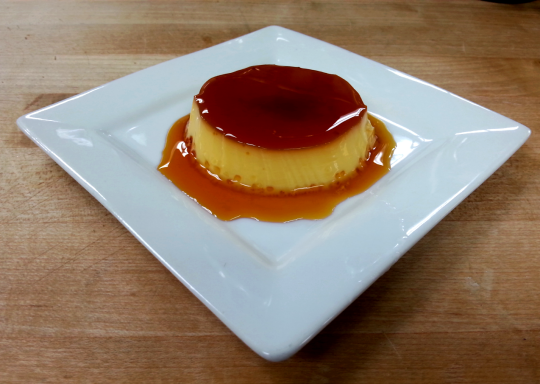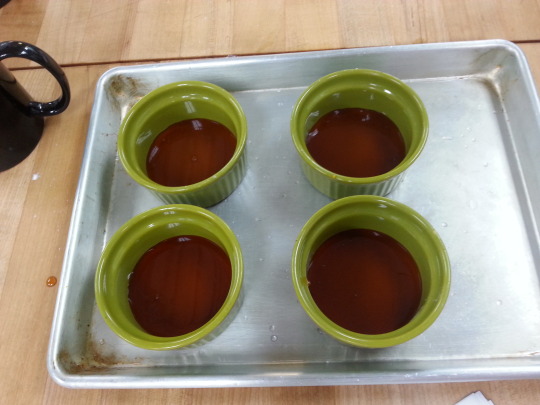Team Shambles
Creme caramel and creme brulee are a big part of why we were excited for the cheesecakes course. Alana has made creme brulee a few times, and talked a little bit about the differences between creme brulee and creme caramel here. The main points referred to the differences in presentation, but didn’t actually look at the differences in the ingredients. Creme brulee only uses egg yolks, while creme caramel uses a combination of whole eggs and yolks. This makes a big difference in the texture of the final product, as yolks are much richer.

“Creme caramel is the cheaper cousin of creme brulee.”
– Chef Marco
Creme caramel seems like it would be a French dessert but they actually originate from Spain, where they are referred to as “flan”. They came about because egg whites were used to clarify wine, but there was no practical use for the yolks. All of these sad and unloved yolks ended up in the hands of nuns, who invented various custard-based desserts! Thank you nuns!

CREME CARAMEL (4 ramekins)
INGREDIENTS
- 125 g sugar
- 30 mL water
- 50 g granulated sugar
- 2 eggs
- 1 egg yolk
- 250 mL homo milk
- vanilla extract
- lemon zest
DIRECTIONS
- Pre-heat oven to 300 F.
- Heat the sugar on a saucepan (gradually adding the sugar as it starts to melt) at low – medium heat.
- When the sugar gets to be a deep amber colour and starts foaming, add the water (in parts) to stop the cooking. Watch for steam as this is a sign that your caramel will be done soon.
- Pour the caramel ~3 mm high inside the ramekins, and let cool.
- Whisk together the eggs, yolk, and sugar.
- Heat the milk, vanilla, and lemon on a saucepan until it comes to a rolling boil.
- Remove milk from heat, and whisk with egg mixture.
- Strain mixture through a sieve and pour on top of the caramel in the ramekins. If there are bubbles on top, you can blow torch them out.
- Poach in a water bath for ~40 minutes, until there is barely a jiggle in the middle of the creme. Check frequently to monitor progress.
- Put in the fridge overnight to set.
“Always strain the mixture. You’ll be amazed what you find in there.”
– Chef Marco
Notes:
- As you cook the caramel, pay attention to the colour of the sugar when it drips off of your spoon.
- While the creme sets overnight, the moisture will dissolve some of the sugars to make the sauce that falls around the creme when it’s turned out of the ramekin.
- If you have a lot of bubbles on the sides, it is overcooked.
- Once the caramel begins foaming, you have about 5 seconds to add the water.
- This is meant to be served upside down. Use a knife to release the creme from the ramekin, avoiding a sawing motion.


Bubbles indicating that the creme caramel was in the oven for too long. Sadness 😦